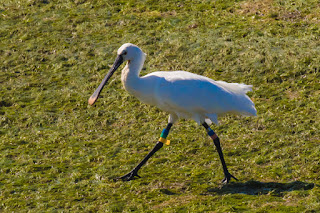Having said all that, we’ve been birding most days since our return and it’s been great. Mostly we’ve been in the Ria Formosa but there have been days around Castro Verde to see the specialities of that area and we have had a couple of trips to Sagres where raptors and seabirds are the main attractions; we also spent some time with the team from Brewood Ringers who had another very successful visit to the Parque Ambiental de Vilamoura.
Spanish Imperial Eagle
As always, there’s been lots to see in the Ria Formosa. It isn’t difficult to find 20 or more shorebird species in a morning around the tidal areas and saltpans and it’s usually possible to see six gull species without too much difficulty. There was a Pectoral Sandpiper last month and a Red-necked Phalarope but so far nothing more exotic than those. It’s fair to say that not everyone we take birding shares our enthusiasm for waders and gulls and still we find that Little Bitterns, Black-winged Kites, Western Swamp-hens and Bluethroats are the biggest ‘crowd-pleasers’.
One or two Yellow-browed Warblers have appeared in recent days but rare passerines have otherwise been missing. In former years the ringers have produced the goods – we remember a Common Yellowthroat, Common Rosefinches, a Paddyfield Warbler and an Aquatic Warbler turning up in mist-nets at Vilamoura in the recent past but this year their success was simply in the actual number of birds they caught and ringed rather than finding rarities – 1903 birds of 56 varieties! Their efforts once again underline the importance of the Parque Ambiental to a wide selection of migrant species.
Iberian Green Woodpecker
Common Kestrel
At Sagres we managed to see a reasonable number of raptors but to be honest it would have been nice to view them at closer range. Some days they come closer to Cabranosa than others and we just haven’t been lucky. Highlights there so far (and there’s plenty of time left for more) have been two Rüppell’s Vultures and a Lesser Spotted Eagle. We did get a distant view of the eagle, coincidentally on the same date that we saw a much closer one in 2015.
Highlights among the seabirds have been two Brown Boobies and a Yelkouan Shearwater, both seen from Cape St Vincent. Whilst there is a nice photograph of the Brown Booby, the shearwater record may not have such an easy passage through the hands of the Rarities Committee. We went out to sea about nine miles with Mar Ilimitado and on a fairly calm day saw Cory’s, Balearic & Great Shearwaters, European & Wilson’s Storm-petrels, Northern Gannets and just one Great Skua. Maybe it wasn’t the most productive trip we’ve ever done but it was certainly memorable. There were close encounters with a Fin Whale, several Striped Dolphins and far more Common Dolphins than we have ever seen before.
Fin Whale
Common Dolphin
European Storm-petrel
Cory's Shearwater
Five Cory's and one Balearic Shearwater
Spoonbill (ringed in The Netherlands)














No comments:
Post a Comment